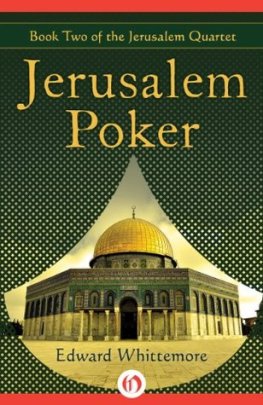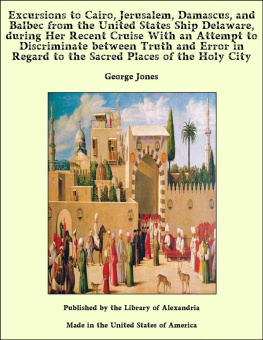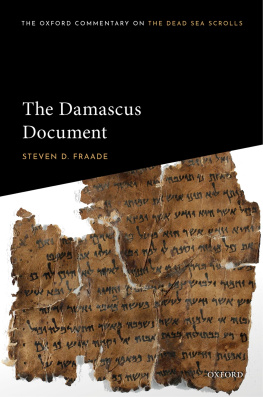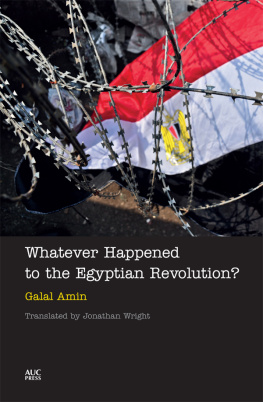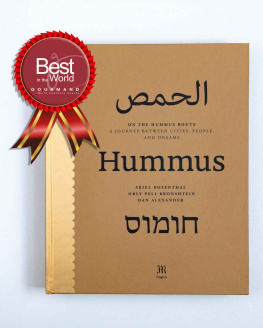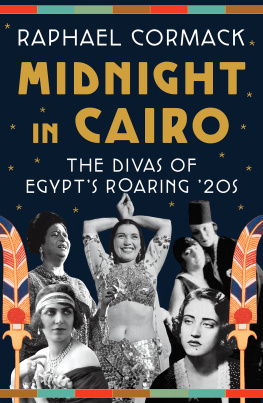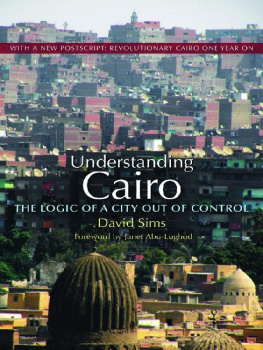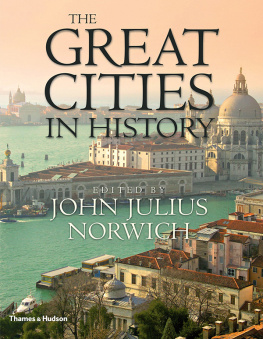Cairo, Jerusalem & Damascus
Three Chief Cities of the Egyptian Sultans
DAVID SAMUEL MARGOLIOUTH
Cairo, Jerusalem & Damascus, D. S. Margoliouth
Jazzybee Verlag Jrgen Beck
86450 Altenmnster, Loschberg 9
Deutschland
ISBN: 9783849649685
www.jazzybee-verlag.de
admin@jazzybee-verlag.de
Availability: Publicly available via the Travelers in the Middle East Archive (TIMEA) through the following Creative Commons attribution license: "You are free: to copy, distribute, display, and perform the work; to make derivative works; to make commercial use of the work. Under the following conditions: By Attribution. You must give the original author credit. For any reuse or distribution, you must make clear to others the license terms of this work. Any of these conditions can be waived if you get permission from the copyright holder. Your fair use and other rights are in no way affected by the above." (Status: unknown)
CONTENTS:
PREFACE
THE task of composing the letterpress to accompany Mr Walter Tyrwhitt's paintings of scenes at Cairo, Jerusalem and Damascus was offered to the present writer, an occasional visitor at those cities, as a relief from the labour of editing and translating Arabic texts. The chance of being associated at any time in his life with the Fine Arts constituted a temptation which he was unable to resist.
The account of Cairo has been based on the Khitat Taufikiyyab Jaddiah of Ali Pasha Mubarak, corrected and supplemented from various sources, especially the admirable memoirs published by the French Archaeological Mission at Cairo, and bearing the names of Ravaisse, Casanova, and Van Berchem. Monographs dealing with particular buildings have been used when available, especially those of Herz Bey: the author regrets that he has not been able to get access to all this eminent architect's works. Of historical treatises employed he need only mention the History of Modern Egypt (Arabic) by his friend, G. Zaidan, which has been of use especially for the Turkish period.
For Chapter XI (Jerusalem) the author must acknowledge his obligation to the works published by the Palestine Exploration Fund, especially those by Wilson, Warren, Conder, and Lestrange. For Chapter XII (Damascus) he has derived much help from the Dscription de Damas, translated, with an excellent commentary, by M. Sauvaire of the Institut in the Journal Asiatique, sr, ix, vols 3, 4, 5, 6, and 7.
The architectural paragraphs have been either revised or written by Mrs Margoliouth, who has had training in architectural drawing. The treatises on Arabic Art of Gayet, Saladin, and Lane-Poole have been studied with profit. The author has, however, abstained from consulting the work of the last of these writers on Cairo: for, owing to Mr Lane-Poole's unique qualifications for dealing with this subject, the perusal of his book might have involved anyone else writing on the same theme in plagiarism.
Oxford, September, 1907.
CAIRO
Chapter I Cairo before the Fatimides
IF modern Egypt is a doubly dependent country, tributary to one empire, and protected by another, a few centuries ago it claimed to be not only independent but imperial. Its capital, Cairo, was founded when the power of Baghdad was already declining, and for two centuries it maintained a Caliph who contested with his Eastern rival the possession of Syria, Palestine and Arabia. And when in the thirteenth century the Mongol storm wrecked the great metropolis of Islam on the Tigris, it was at Cairo that sovereigns arose capable of rebuilding an Islamic empire, and repelling the Mongols beyond the Euphrates. For two-and-a-half centuries Cairo remained the capital of western Islam, and the seat of the most powerful Mohammedan state, sending out governors to many provinces, and recognized as suzerain even where it did not appoint the ruler: being itself the laboratory of a political experiment perhaps never tried elsewhere. Its monarchs bore the title Slaves (Mamluke), not in mock humility like the Servus servorum Dei, but in the plain and literal sense of the term. The occupant of the throne was ordinarily a Turk, Circassian or Greek, who had been purchased in the market, and then climbed step by step, or at times by leaps and bounds, a ladder of honours at the top of which was the Sultan's throne. A slave with slaves for ministers constituted the court, and men of the same origin officered the army. The talents which had raised the first sovereign to the first place were rarely, if ever, handed on to his offspring; the natural heir to the throne could seldom maintain himself on it for more than a few months or years. To have passed through the slave-dealer's hands seemed to be a necessary qualification for royalty.
In the country which gave them their title these rulers housed as strangers. To its religion they indeed conformed, but with its language they were usually unfamiliar. The life of the nation was affected by their justice or injustice, and the wisdom or unwisdom of their policy internal and external; but in the nation they took no root. Hence one battle displaced them for the Ottomans, just as one battle in our day put the country under the power of Great Britain.
Cairo then eclipsed Baghdad, to be eclipsed after two-and-a-half centuries by Constantinople; but to the dynasty under which it reached the zenith of its fame and power it did not owe its foundation. That took place in the tenth century A.D., when an army was sent to invade Egypt by the descendant of a successful adventurer, who, claiming to be of the Prophet Mohammed's line, had founded a dynasty in North Africa. The place where this army had encamped, after capturing the older metropolis, was chosen to be the site of the new one. And it was called Victoria (Khirah) in commemoration of the conquest already achieved, and as an augury of others to be won.
Those who found cities to inaugurate new dynasties ordinarily keep near the beaten track. Cairo is but two miles to the north of Fostat, which had been the capital of the country from the time of the Mohammedan conquest. Its name is the Latin word Fossalum an entrenchmentand it was the camp of the conquering army which, under Amr son of al-As, had wrested Egypt from the Byzantine empire, and
THE SENTINEL OF THE NILE.
which was made the seat of government because the Caliph of the time would have no water between his capital, Medinah, and any Islamic city. This is why the capital of Greek and Roman times, Alexandria, lost its pre-eminence. Fostat itself was not far from the remains of the ancient Memphis, and a city called Babylon, supposed to date from Persian times.
For some time the new city kept growing by the side of the old city without the latter losing much of its importance or its populousness, of which fabulous accounts are given by persons professing to be eyewitnesses. At one time it was supposed to contain 36,000 mosques and 1,270 public baths. A description of the fourteenth century, when it had long been on the decline, still gives it 480 small and 14 large mosques, 70 public baths and 30 Christian churches or monasteries. Fostat was celebrated not only for its size, its populousness and the wealth of its stores, but also for the foulness of its airfor the mountains screened it from the fresh breezes of the desertand the carelessness of its inhabitants with regard to the most elementary precautions of cleanliness. Dead animals were flung into the streets and left there; the gutters discharged into the same Nile whence water for drinking was raised in myriads of buckets. The cause, however, of the eventual desolation of Fostat was not its unhealthiness, but the act of ruler of Egypt. Shawar, nominally vizier but really sovereign, in the year 1163 having to defend the country at once against the Franks and against a rival from Syria, despaired of saving the double city; so he committed the older capital to the flames. Twenty thousand bottles of naphtha and ten thousand lighted torches were distributed by his orders in Fostat, whence all the population had been cleared, to be harboured in the mosques, baths and wherever else there was space in Cairo. For fifty days the ancient city blazed; when at last the flames were extinguished, all that remained of the capital of the first Moslem conqueror of Egypt was a pile of ashes.




